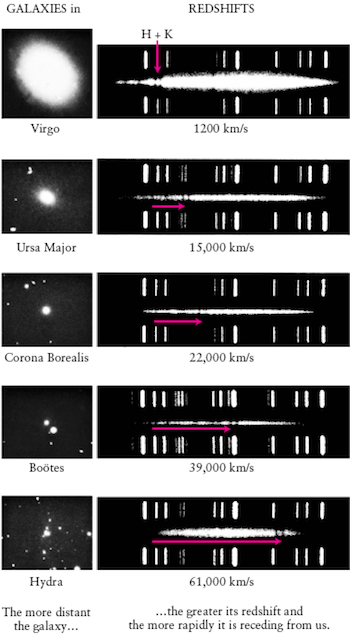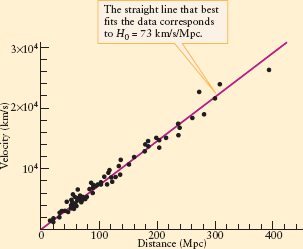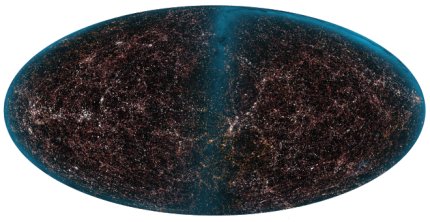Chapter 26. The Expanding Universe
26.1 Introduction

Author: Scott Miller, Penn State University
Editor: Grace L. Deming, University of Maryland

The goals of this module: After completing this exercise, you should be able to:
- Explain why galaxies farther away from us exhibit a greater redshift than closer galaxies.
- Describe the basic idea behind the Big Bang event.
- Describe how the universe is expanding and what it is expanding into.
In this module you will explore:
- How astronomers know that the universe is expanding.
- How astronomers estimate the age of the universe.
- Why astronomers believe that our universe has no center and no edge.
Why you are doing it: Observations of distant galaxies suggest that they are moving away from us at fast speeds, but indicate something much more important. The universe itself is expanding! This naturally leads us to seek answers to some fundamental questions: Where did it all begin? What is it expanding into? How long has the expansion been going on? This activity will help us begin to answer these questions.
26.2 Background

During the 1920's, Edwin Hubble and Milton Humason observed a number of galaxies and collected spectroscopic data on them. They discovered that, in general, the spectra of galaxies show a redshift in their spectral lines, as shown above. In other words, galaxies appear to be moving away from us in all directions. In addition, it turns out that the farther away a galaxy is from us, the faster it appears to be moving away from us. Below is a plot of the apparent recessional velocities (v) of a number of galaxies versus their distance (d) from us. Hubble discovered that the best fit to the data suggests a linear relationship between these two parameters. This relationship is now known as Hubble's law, and can be written as:
v = H0d
where H0 is known as Hubble's constant, the constant of proportionality between the apparent recessional velocities of galaxies and their distances. Our current best fit to the data yield a value for Hubble's constant equal to 73 km/s/Mpc.

When we plot the apparent recessional velocities of galaxies at various distances, we discover a linear relationship between the two.
Question 26.1
tGjkfwhi6dHFzM8JylIrgAUp26ADSBSCjSitbJNB9lo+7+OZ1Zmnpi682PZAEpTySg4AEp7fpcBH97GU9R8vwbsUDZI8U02mMiJpU+6Y8OfgF0OJh2H/tRmBqbPieokamsZtJqNhbhuhVqHUJwtQGmxTbz77LtrWg/BpQe0+U7RFQt6zZOjFqcm3KIrwj4v+FddZ5cJQ7ZVlrNRmtJjn3bwss7+lbCFk26.3 The Expansion of Space
It turns out that the apparent motion of galaxies away from us is not due to their actual motions. On small scales, galaxies have their own motions due to the gravitational forces of nearby galaxies, but on large scales, something else is going on. It turns out that the large scale movement of galaxies which we observe as a redshift in their spectra is not due to their actual motions, but rather due to the expansion of space itself.
Think of the universe as the surface of a balloon. Over time, the balloon is being inflated, and its surface is expanding. Galaxies are like little dots on the surface of the balloon; as the balloon expands, they all appear to move away from us. The farther away a galaxy is from us, the faster it appears to move away from us. This is due to the expansion of the universe, not the motions of the galaxies (which is why we call their motion their apparent recessional velocity). Watch the animation.

The animation above demonstrates the expansion of the universe in a two-dimensional model. Watch how the galaxies move in relation to their original starting places (a lighter shade of the original grid remains), as well as relative to the expanding grid.
Question Sequence
Question 26.2
s617qEwjOPnUDkzUOTJccHtPVKHgP4v2iqw64A6gQ83CjGzZH4QDfpUIUiMpS38e+zmlcatpDH2GA1zLtvsFcm3+uWo0y0Qv0XlXpi2vrRubAUF6KKfI8qs3PZkasJAQ+8lYLe3nJe1FJwTVUF6ybKnNM6YLfwQ/SHCOvimo5DDWJ4q3JWWJuecIzvyWE+yxiDLYc+DRQOW8v5y2qgCEDVCkctS7d8bQUbo50AlBSsGe6YB8Zk++ukJMTUm0y88ZQuestion 26.3
GVPqdSFfRGI+/M6D+p3A+oto2mfXFS/ehkPs9VZOmlGIbw/A+gzXh31V2y2rCDl9hFCLGMiwzJLBZREzVLDP1CWfahfsEKezZnvWCYGgI/UfehBtKnEv/cNDs/rI39D2np73Ytu7l4Ti/5VBrpbVLvq3DwoaS/Qp+VGcf743RtjI//2MHEh0MQ==26.4 Cosmological Redshift

If the apparent motion of the galaxies is due to the expansion of the universe, and not their actual motion, then why do we measure a redshift for these galaxies? Click on the play button in the animation above to see why?
Question 26.4
zJQ0+qHMqIGwwQVO0nZT4v/VHHUHI03cGHEEBSTLj3wN452vccpMOy1Vdwh29elop+OK3ubc6p07RzPLXKXs4Fn+fhwzHFbPVecWevQA4uYcBXWA9DK6/5qKECr2jRiuBryqsxRBluc3Auv62urutOVpoRIE3NzS/QFDVDvoCEPPDiXFf116wOoWY2CcKiGUL6eHdFfpJLVbsGBh991W2k32uySo4tO19eSAhzzEFuGp16EcuBjXTTYgC5j0slbwaHtByG/KS2Qboj3ZPZnPoTlMgIf5iPhAQRpHtGFewlgp1NI2Y4VR7EHzdDc5GtqsKCSEXvd8cVEQonNWudOpmPAYzf+4jH9NFSawD28BvS0vhTCf9ox4kKSzZir2HU8//AgX2yFxjTgEsBaDfhWwECG4uEUpzl/i7u0L1cTCRKiqWTsn6hke3Njqd+xGdHakB2LKCbh7PWVNbAFdsmiaX/Cj4bmU003ghgaCDlXZ7RLH2nqp+evW0uzkSumLxwIHVusDDA==Summary
As galaxies emit photons of light, their wavelengths become longer as photons move through the expanding universe. The farther away the galaxy is from us, the longer its photons travel through space, and the longer the wavelengths become. This type of redshift is known as a cosmological redshift, and explains why galaxies farther away appear to be moving away from us at faster speeds.
26.5 The Age of the Universe
If everything seems to be moving away from us, what would happen if we could reverse time? If we could watch everything moving backwards in time, we would see all of the galaxies moving towards each other, until the point at which they all reunited into one point. We would see back to the beginning of our universe. If we can calculate the amount of time it would take for all of the galaxies to come together, then we can calculate the age of the universe.

Assume that the galaxies have always been moving at their current speed. How long has it been, then, since our Galaxy and the other galaxies have been traveling away from each other? Speed (v) is a measurement of distance traveled (d) over time (t). If you know how far an object has traveled in a given amount of time, you can calculate its speed. This can be written as:
v = d/t
Using this equation, you can see that if you know how fast an object has been moving over a given distance, you can calculate how long it has been traveling. This can be written as:
t = d/v
Hubble discovered that the velocity of a galaxy is related to its distance from us by Hubble's Law (v = H0d). If we substitute this into the equation above, we get:
T0= d/H0 d = 1/H0
In other words, the age of the universe (T0) is inversely related to the Hubble constant (H0). If we can determine the value of the Hubble constant, we can estimate the age of the universe. Our best estimate of Hubble's constant is H0 = 73 km/s/Mpc. Based on this value, we calculate an age of the universe equal to 13.4 billion years. This is an estimate, though, because
- there is some uncertainty in the exact value of Hubble's constant, and
- it makes the assumption that the galaxies have been moving at a constant speed the entire time (which they have not).
Regardless, this is a good approximation of the age of the universe. Because this value was derived from Hubble's constant, T0 is known as the Hubble age.
Question Sequence
Question 26.5
+LpLv1anPa6Eo3OlCxmC14/Sh1eylnCnxTOBQDUUnPwbqtDT2Kcnh2tWacI70p4hsj/HFKmmVJcy+M+Vyv6HEvMhGB+I62y8TCPPLrIRQ4GHmA3tXdW/vjSsf1KOpVm8UVn22Vlo+TXRY4rFUJUBcYboAnafBes8nwMGw0W1VWaotwmNyui+sOFove0=Question 26.6
0QctLAjZ72iwZfFisWVsRirwA5jdOWp5twfZu0jAonx7zI+mMfRohGN0B42Q183nj85HmLdCJBou0GJ4VHjXH3p8ablECy6FhfLXxrIFSnqp6YBJYjZFnVNnSDr+iosn1H2Ws5daoL1G6MBubCoh/rQQQ5+LJ6Fr6+WlOZEgeikliB68n8VvRW1pIWy+kn3q1+I367Jkv4eMi94p0XHysmOs46fGBjoBpd74r0TPIXNIjQebK5OSjy0X6UOIwR+UQhce1pVd0hlq4RG+BEYYGDgGeAO0JgdaYl65cZLPZ3xOtSsLL5MMDgVRB8q+RuUDyTSz3bqhRhpIRRC+rrRWJ37Ht8Bttm5pyJFi2rxR667wxDIT0b+uySgrdao=_feedback_hint: Try again. What is the relationship between Hubble's constant and the Hubble age?
_feedback_correct: Correct. The Hubble age is inversely related to Hubble's constant; the smaller Hubble's constant is, the longer the Hubble age.
_feedback_incorrect: Incorrect. The Hubble age is inversely related to Hubble's constant; the smaller Hubble's constant is, the longer the Hubble age.
26.6 The Big Bang

If there is a beginning to our universe, what started it all off? During the 1930's until the 1960's, two conflicting models competed to explain the expansion of the universe. One model suggested that the universe was in a steady state. While the universe appeared to be expanding, new material continued to be created such that the overall density of the universe remained the same (even though its volume was increasing). The other model suggested that the entire universe originated from an incredibly dense and hot point that rapidly expanded outward, creating the universe that we know today. Proponents of the first model half-jokingly referred to this second model as "this Big Bang idea". As evidence accumulated supporting this idea, more and more scientists favored the second model, and the term Big Bang stuck.
The Big Bang was not a tremendous explosion in space; it was an enormous release of energy that created space. It did not happen somewhere in our universe; it created our universe. Our entire universe began as a point of zero volume, containing an infinite density of energy. As this energy was released, it expanded outwards, containing all of space as we know it.
What is it expanding into? We don't know, since we can't see outside of our universe, but scientists believe that it is expanding into nothing (again, not space, but absolute nothing). If our universe is finite in age, then what existed before our universe? We don't know, since our laws of physics cannot model the universe back to the time of its creation, or further, but scientists believe that before the universe existed there was nothing, absolutely nothing. It turns out that, scientifically speaking, the state of absolute "nothing" is unstable, and "something" will eventually happen.
Question 26.7
bGugrb/UuGhzjTmTq69O2RDl/WtpWcxgoeiq/nONFdiiZxoxee9qyec7BMHp2sIFrMUzoPAgYh+3jzC1LltFJ+lYWsaBzFDo2iFWiS7xkU9eJFpFpuisQFYT+ie1z00UwIBdObuGjmWTK63+DWCMixdaH+hvHGuq2MXb4H60BE4o0xr1Mbf9kR90dOA+oGxSOB2KrMM0X4MfuNfl1Z4fOK535D3Lg2mOxB4V5W8FVzWPidBkl7UG+HfmMaVe99hh3Y23eI8yin+YlCjFrUzRXnOWfrNcZglR188+d671ziulPoLYUwNlnGuhgj/lQi6TfdDyWw/Y00gccFpRCmuLcrhCeTMTz5FiZKLYcELb011ETsk8qUJX1axWFw6dJEHMk3y9+g5hMDQIlu+c5bW9l0qsp8QAVE4py/A2e+HnNBDAdvZGpuYTioB4iXX0BfJEIZX2LOFQI/G1wuwS26.7 The Cosmological Principle

Once scientists gathered observational evidence supporting the Big Bang theory, they were also able to mathematically model the universe and derive certain properties that are consistent with the Big Bang theory. Two of these properties describe how material is distributed throughout the universe on large scales, and collectively are known as the cosmological principle.
The first half of the cosmological principle states that the universe is homogeneous. Homogeneity states that, on large scales, the universe looks the same in all places. Standing on Earth, orbiting around the Sun and moving through our Galaxy, I look out and notice that galaxies tend to form in clusters and superclusters, organized along filaments with voids between them. If I lived on another planet, orbiting another star in another galaxy on the other side of the universe and looked out, I would see the same universal structure. My view would not be identical, but the overall structure of the universe would be the same on large scales.
The second half of the cosmological principle states that the universe is isotropic. Isotropy states that, on large scales, the universe looks the same no matter which direction I look. Looking out from Earth, if I look in one direction I see clusters and superclusters of galaxies, forming along filaments with voids in between. If I look in the opposite direction, I see the same large-scale structure. My view is not identical, but the overall structure of the universe is the same in both directions.
Question 26.8
6eQc0ppaZ4g38E8xV9+RgAP/SIG6K+CYzq6XK0NzwMaWCvgCmQrp6x2sjkbjhVhuWtPxwWi/7JiQTA+Ea8ANEJ7obiPN7D2OlaJYU4rFvODqeCmcLn+tGz9oDLbyWmzDLikaqcQSjT0AwpmgLt/g9jUaaQE/874eqPdRKWrtK7myqXsgnKFskplXzduUFSKA0NNNyld7dCYuDqGV/JtUTbdY5CG044vFnxjvFA==26.8 The Center of the Universe
Since we see everything moving away from us, and farther galaxies appear to be moving away from us faster, does that mean that we are at the center of our universe? Watch the animation below to find out.

Question 26.9
h03vAcm8WYeRLn2gpGUFJiED5DOG7xX5sbTgGodOQGJLQmD5x896ty3qt7QVt4pF6jFHntsXJZmRPXmruwjuE7kUcKuM89RftjDIGcQfzRCez5GHjPxM26Ra6INkg7BaAp/UNOU0WzJaFw8JJ63wrRR/7IKScWYZ/qOFdi/ksNjvXpp5mOw6m/FC0hy2el6dtl4qY/9f99JaUxKNY0WlaFq3/5ZdvITqMBOKgFohIO8lpjwmLLnGs4EXfl6BEffjx3C08XR/BTnlnhBoiuBl/p9fWKZZR1JsEggzGcQvL3cUAfmaQZy8IQW++YHRMhql7dZiUGYe7n3Vj+cthzTq2bCmiHptMbIvLWY2ycI7KFH1VlhFuFSJnvYlN9ZAWUtnjz29ajYBiRstQUeGGX8j1YTZgyxKlEXYWpxILOGMv6Et6TVJd3azYoSlA7zecaL5XTjhqWf2luRf+7+lxHYoWRGacEAdKxQwKyTP9P19IWpppJzIQd94OCRDgYNb5hlhI5vinqU09PvnfnnXBpgaOd7eqbYjz8ZK7kwnDDmSpL9aI4eDTqIDVTGOHZNkauWR489c2KB8cik8By/2grreRsQLzOet6OMCjiTQl5YFNf13vPIXiJzhgEGyc8Gx4ljI/2LWa9XVd+DA/VVC6qygrONBSBK1rCCmQsAln8tBq2IphDk6cMmhQvMpBsbvsCW/BQ47YA==As you can see from the animation, if we live in galaxy A, every other galaxy appears to move away from us, and farther galaxies appear to move away faster. This is consistent with Hubble's law. If we live in galaxy B, we see the same thing; all other galaxies appear to move away from us, and farther galaxies move away faster. This is consistent with the Cosmological Principle. The universe is the same everywhere; Hubble's law applies everywhere.
Well, if we are not at the center of the universe, then where is the center? There is no center of the universe. The universe began with the Big Bang, a tremendous release of energy from a point volume. That point WAS the universe, and the universe expanded outwards from it. There is no center to our universe, because that would suggest that the Big Bang occurred somewhere in our universe, and it did not, it created our universe.
Question 26.10
kiK4FqHnfXwmCBNm7EfMNJ8nGsIS4gnyLw0bzteudoud/LxfawSuzL5AnXjqw3cMnDHz/UODNDW9mLNxPJypM9s32Op54GjXp+gbQms2rycyV8OYc5Mmn5ecfIOH29h1wcwDm9kdsvpPmsP/rIHyTkJkrlQqlSc5t6e2zzxBa9w=Summary
Just as there is no center to our universe, we can also state that there is no edge to our universe either. If there were an edge to our universe, then there could be someone living in a galaxy located on the edge of our universe. As that person looked out into the universe, they would see the entire universe in one direction, but nothing in the other direction. This violates the cosmological principle. Therefore, we can say that not only does our universe not have a center, but it doesn't have an edge either.
26.9 Quick Check Quiz
Indepth Activity: The Expanding Universe